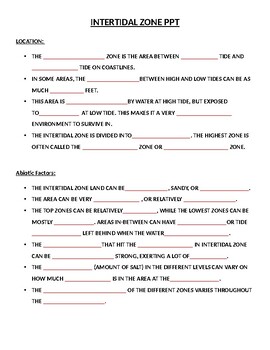Semenko Super Science
28 Followers
Grade Levels
4th - 10th, Homeschool
Subjects
Resource Type
Standards
CCSSRI.6.4
CCSSRI.6.7
NGSSMS-LS2-2
NGSSMS-LS2-4
NGSSMS-LS2-1
Formats Included
- Word Document File
Pages
2 pages
Semenko Super Science
28 Followers
Description
This two page word document is a FREE guided notes handout that accompanies my Intertidal Zones of the Marine Biome PPT lesson. Students follow along with the lesson by filling in the missing words (colored red) from the informational slides.
To purchase my Intertidal Zones of the Marine Biome PPT lesson, check my profile- Semenko Super Science.
Total Pages
2 pages
Answer Key
N/A
Teaching Duration
45 minutes
Report this resource to TPT
Reported resources will be reviewed by our team. Report this resource to let us know if this resource violates TPT’s content guidelines.
Standards
to see state-specific standards (only available in the US).
CCSSRI.6.4
Determine the meaning of words and phrases as they are used in a text, including figurative, connotative, and technical meanings.
CCSSRI.6.7
Integrate information presented in different media or formats (e.g., visually, quantitatively) as well as in words to develop a coherent understanding of a topic or issue.
NGSSMS-LS2-2
Construct an explanation that predicts patterns of interactions among organisms across multiple ecosystems. Emphasis is on predicting consistent patterns of interactions in different ecosystems in terms of the relationships among and between organisms and abiotic components of ecosystems. Examples of types of interactions could include competitive, predatory, and mutually beneficial.
NGSSMS-LS2-4
Construct an argument supported by empirical evidence that changes to physical or biological components of an ecosystem affect populations. Emphasis is on recognizing patterns in data and making warranted inferences about changes in populations, and on evaluating empirical evidence supporting arguments about changes to ecosystems.
NGSSMS-LS2-1
Analyze and interpret data to provide evidence for the effects of resource availability on organisms and populations of organisms in an ecosystem. Emphasis is on cause and effect relationships between resources and growth of individual organisms and the numbers of organisms in ecosystems during periods of abundant and scarce resources.



